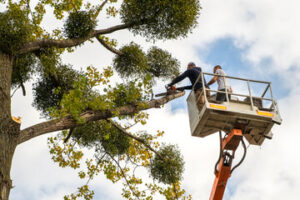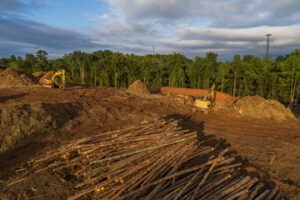Affordable Tree Service Richmond VA can keep your landscape beautiful and safe. They can help you identify diseased or dead trees and invasive species that interfere with a healthy ecosystem.

They use specialized equipment to prune and remove trees and limbs. They can also improve soil conditions by aerating and fertilizing the roots. They ensure that all work complies with local construction codes.
A professional Tree Service can safely remove any tree from your landscape and do so without compromising the health and value of your property. Preparing adequately, executing carefully, and following safety protocols all contribute to making the process as smooth as possible and mitigating the risks of injury or property damage.
Regular maintenance and preventative care are the best ways to promote healthy trees. Keeping an eye out for pest infestations, diseases, and structural weaknesses can help you mitigate emergency situations before they escalate. Tree services can also use cabling and bracing techniques to support and stabilize weak or unstable branches and trunks, reducing the risk of collapse and extending the life of your trees.
Emergency tree removal is a complex process that requires specialized knowledge and equipment. If left unattended, a damaged or dying tree can pose serious threats to people and buildings. Identifying a hazardous tree can be difficult, but signs of potential danger include sudden or heavy leaning, rot or decay in the roots, visible cracks or damage to the trunk, and extensive soil erosion around the base of the tree.
During an emergency tree removal, professionals follow strict protocols to ensure the safety of their workers and surrounding properties. They use a variety of specialized tools to perform safe and efficient cuts, including chainsaws, cranes, and rigging systems. They also utilize specialized equipment for maneuvering within tree canopies, such as climbing lines and double rope techniques.
In addition, Tree Time is fully insured to protect property owners from liability in the event of an accident or damage during the removal or replanting process. This insurance coverage is a testament to our commitment to safeguarding our clients and employees.
A tree is a significant investment for any property. Proper care and maintenance can extend the life of your trees, as well as enhance your property’s curb appeal. A good Tree Service will assess your property, identify any issues, and provide recommendations to improve the health and appearance of your landscape. For more information about safe, efficient, and affordable Tree Service, contact Edmonds Tree & Landscape Service today!
Efficient
When you hire a professional tree service provider, you can count on efficient work that minimizes property damage and saves costs. The right company uses the latest equipment and technology to ensure quality, safe, and timely services. Look for a company that has years of experience and certified arborists.
This will ensure that your trees are cared for properly, improving the beauty and health of your landscape. The best providers are also available around the clock for emergencies, ensuring that you can receive help quickly and avoid costly damages.
Regular inspections and monitoring can prevent minor issues from escalating into major problems that require expensive repairs or removal. For example, a minor tree health issue like insect infestation or structural defects can be prevented with early intervention. In addition, regular nutrient enrichment promotes healthy growth and reduces the risk of diseases and pest infestations.
Proper pruning can also help reduce costs. Regular trimming allows your trees to maintain their shape while reducing the need for future maintenance. This prevents dead limbs from falling and damaging your home or yard, and helps your trees remain healthy and beautiful.
Other cost-saving measures include soil aeration and nutrient enrichment. These practices can improve your soil conditions, allowing for better root growth and lessening the need for expensive tree services in the future.
A good provider will also adhere to local regulations for safety and efficiency. They will use modern tools and techniques, such as GPS and GIS to map out and execute operations, minimizing risks for everyone involved. This will also allow them to provide you with a more detailed report and documentation that can help with your insurance claims.
When choosing a tree service, make sure to read reviews and testimonials. You should also look into their certifications and insurance to ensure they are a reputable and reliable choice. Finally, choose a provider who offers free quotes so you can budget for the work needed on your property. The best providers will take the time to analyze your needs and come up with a customized plan that fits your unique landscape.
Environmentally friendly
Trees have a significant impact on our environment, providing oxygen and improving soil quality. They also improve air quality, protect buildings and structures, and provide habitat for wildlife. While the removal of a tree is often necessary, it should be done in an eco-friendly manner that preserves the surrounding ecosystem. For example, precision cutting and the use of low-impact machinery minimize environmental damage. Additionally, the process should involve a thorough assessment to ensure that the tree is not a safety risk or poses a threat to other trees.
Tree service can include a wide range of services, from pruning to cabling. Pruning removes dead limbs and improves a tree’s aesthetics, while also allowing the tree to direct energy toward growth. In addition, it helps prevent pests and diseases by removing diseased limbs before they spread. Moreover, a professional tree service can also prune to promote new growth and shape a tree’s crown.
Another important aspect of tree service is the eradication of invasive species, which are non-native plants that disrupt a tree’s natural canopy and compete with native plants. Invasive species are difficult to eradicate and can be costly for property owners, but a professional tree service can remove them quickly and efficiently using state-of-the-art equipment.
In addition, tree care can help to promote soil health by reducing nutrient runoff and minimizing evaporation. It can also reduce the need for chemical pesticides by encouraging the proliferation of beneficial insects that will naturally control invasive insect populations.
Lastly, regular trimming and tree care can prevent damage during storms and high winds. By removing loose or weakened limbs, these services can significantly increase a tree’s ability to withstand extreme weather events.
Tree services are essential for maintaining the health and beauty of your landscape, but they can be dangerous to perform without proper training and equipment. A professional tree service company will have a team of highly-trained arborists with the knowledge and skills to handle any type of tree. They will be able to identify any problems and provide expert advice, ensuring that your trees are healthy and safe.
Affordable
Tree service providers offer a wide range of services to help property owners keep their outdoor spaces safe and accessible. These include: tree removal, crane service, stump grinding, and lot clearing. They also perform regular inspections, pruning, and disease management. They use specialized equipment and techniques to minimize the risk of injury to themselves and their clients. The cost of these services varies depending on the specific task. For example, tree removal is typically more expensive than pruning. Other factors that affect the cost of a job include the size and location of the tree, its health and stability, and access limitations.
A dead or dying tree is a serious hazard, and it’s important to have it removed as soon as possible. If it falls, it could damage your home or car, or injure someone. In addition, a decaying or dead tree is a breeding ground for insects and fungi. It’s also a fire hazard and can contribute to erosion.
When a tree becomes damaged, it’s important to have it assessed and restored as soon as possible. Professionals are available twenty-four hours a day to provide emergency tree service, and they can even respond after a storm or unexpected event.
Regular trimming and yearly inspections are key to maintaining the health and appearance of your trees. Professional tree service providers can prune your trees and remove limbs that pose safety risks, improve airflow, and promote growth. They can also help you manage disease and insect infestations.
Snow removal is an essential service for keeping your property accessible during winter weather. While it may seem straightforward to clear paved surfaces, professional snow removal requires skill and precision. Skilled tree service providers understand the complexities of this task and leverage specialized equipment to efficiently and thoroughly clear snow from all outdoor areas.
Having an attractive and well-maintained landscaping is crucial for maintaining the value of your property. However, not everyone has the time or expertise to maintain their landscapes. Professionals can handle all your Tree Service needs, including pruning, mulching, and stump grinding. With their years of experience and extensive training, they can provide you with the best quality service for your landscape.



